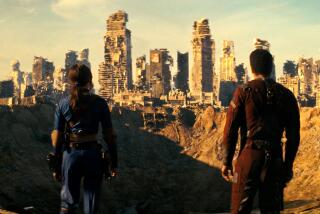The real mystery is why ‘Whiteout’ got released
- Share via
It doesn’t take long for the flashbacks to start piling up for U.S. Marshal Carrie Stetko (Kate Beckinsale) in the anti-mystery movie “Whiteout.” Now working in Antarctica, Marshal Stetko keeps climbing in the wayback machine and remembering her bad old law-enforcement days in Miami where an arrest went awry while bad salsa music played in the background.
“It’s like it’s 85 degrees and 85% humidity,” Stetko tells a colleague of the sweaty scenario, which may partly explain why in the first 10 minutes of this laughably lame film, Beckinsale peels off her clingy white underwear and hops into the shower. More likely, though, studio suits balked at the idea of Beckinsale bundled up in a parka for the duration of a 100-minute movie. How are you going to sell that?
How indeed? Adding to the movie’s list of dubious virtues is “Whiteout’s” unrestrained employment of exposition. In this long-gestating, committee adaptation of Greg Rucka and Steve Lieber’s graphic novel, no event occurs without a character telling us what we’re seeing. This unwelcome commentary is so overdone that it becomes, by the end, an invitation for audience participation. All together now: It’s a body! Looks like it’s been shot in the head!
There are plenty of corpses in “Whiteout,” most of them belonging to a group of Russian soldiers whose cargo plane crashed in Antarctica half a century ago after an in-flight cold war. The Russkies were killing each other over the mysterious contents of a safe and, 50 years later, it looks like the killing is going to start all over again under Stetko’s watch.
Stetko is defined by her undergarments and trust issues, and she has plenty of reasons to suspect that the current wave of homicides might be an inside job. Director Dominic Sena (“Swordfish”) telegraphs the culprit almost as quickly as he puts Beckinsale in the shower, but Stetko must labor for the movie’s duration, fighting flashbacks and ax-wielding bad guys.
The graphic novel used the Antarctic setting to create a sense of bleak despair, much like John Carpenter did in his 1982 remake of “The Thing.” Sena jettisons that hopelessness, casting Antarctica (Manitoba fills in for the film) as a winter wonderland, though the CG-created southern lights look as awe-inspiring as a tub of Rite Aid rainbow sherbet.
No need to worry, though: “Whiteout” helpfully employs a character to tell us just how spectacular those lights are. Again and again and again.
--
--
‘Whiteout’
MPAA rating: R for violence, grisly images, brief strong language and some nudity
Running time: 1 hour, 41 minutes
Playing: In wide release
More to Read
Only good movies
Get the Indie Focus newsletter, Mark Olsen's weekly guide to the world of cinema.
You may occasionally receive promotional content from the Los Angeles Times.









